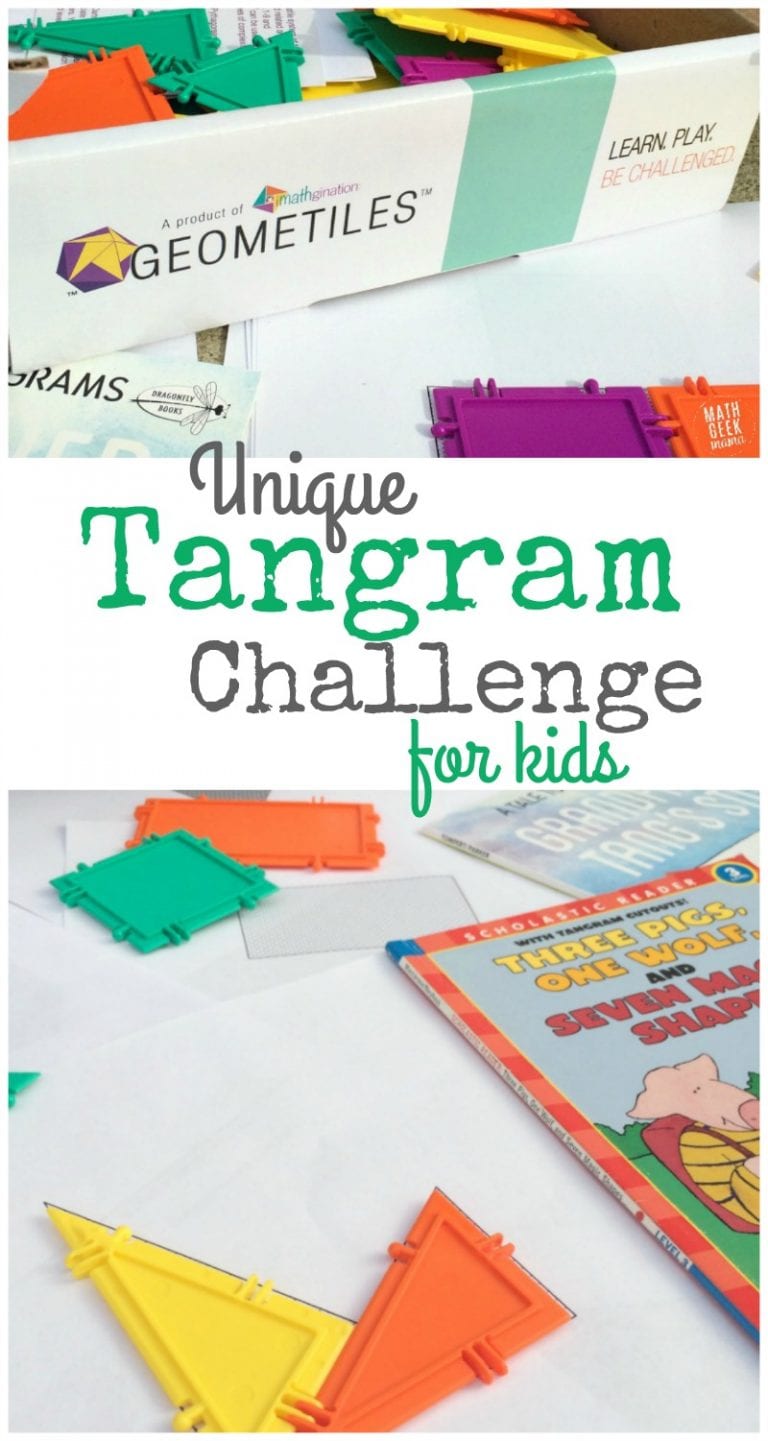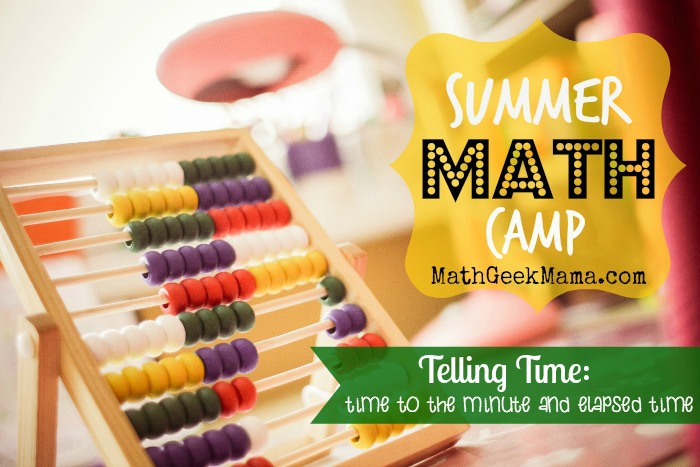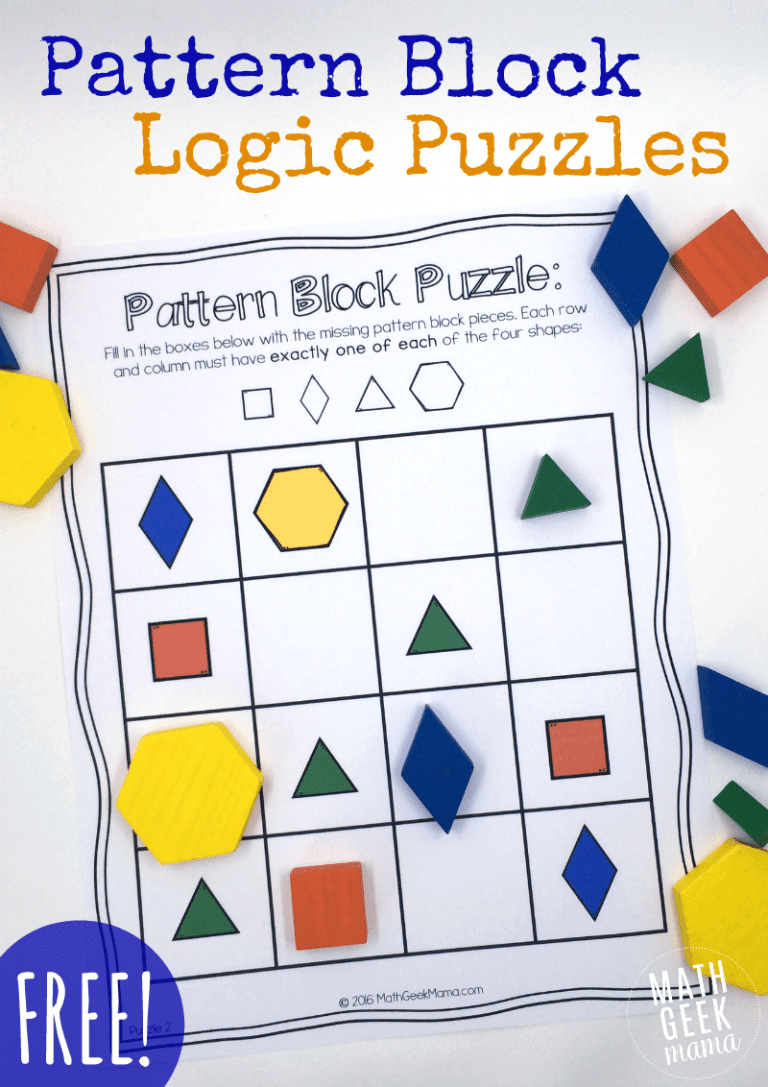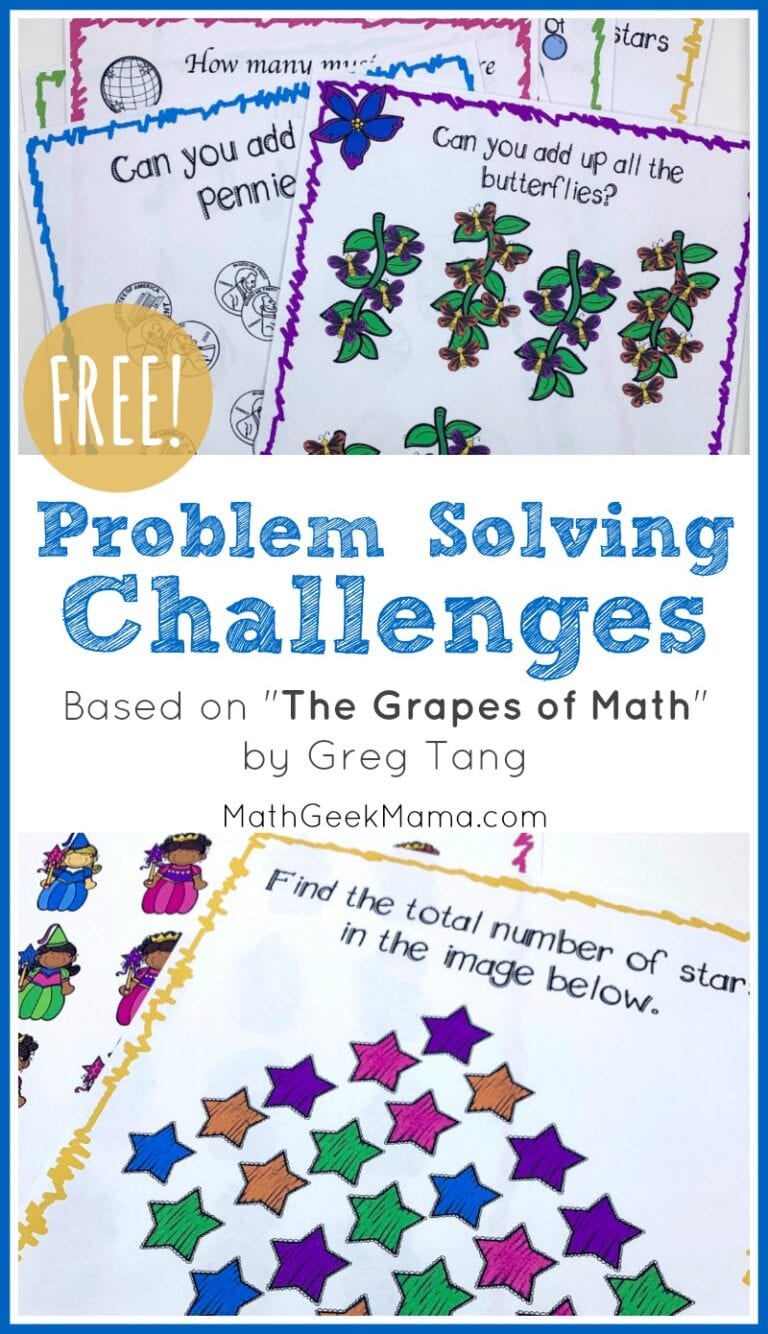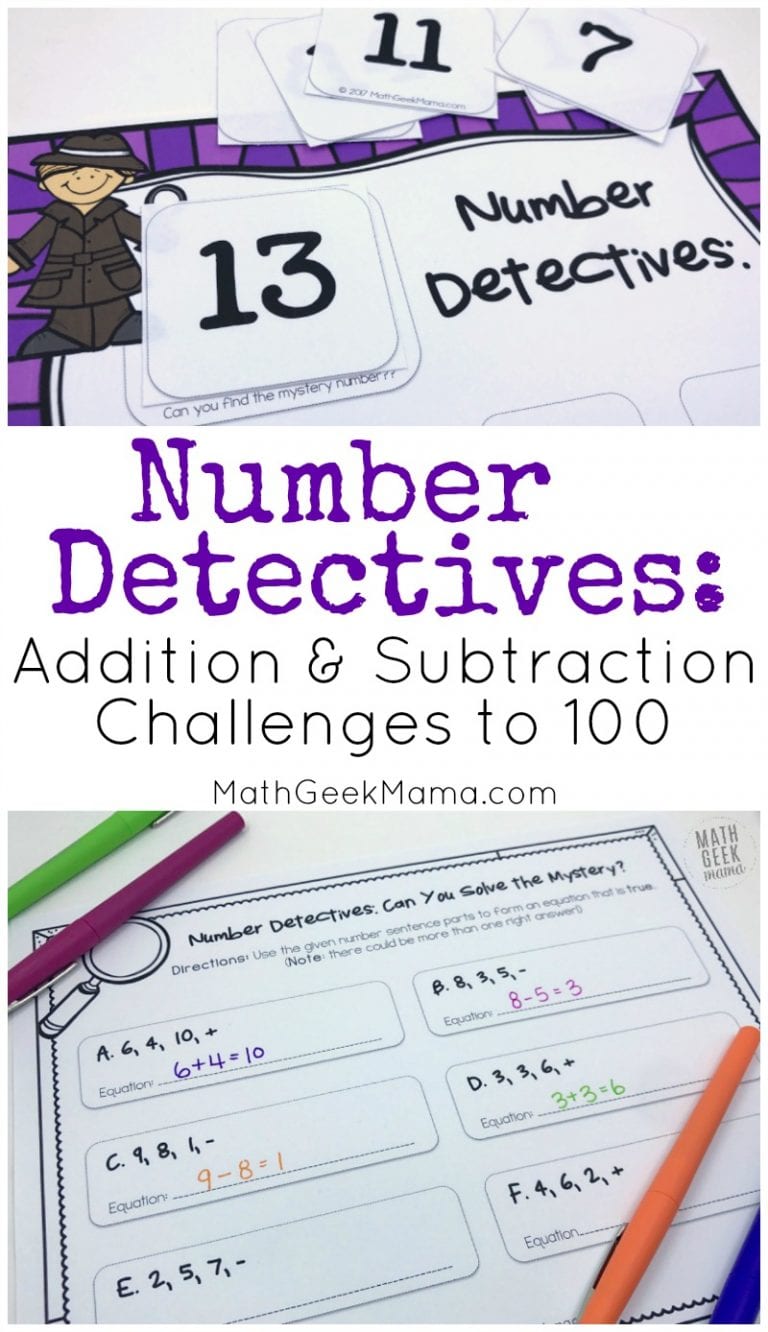Simple Daily Math Warm-Ups to Build Number Sense
Looking for a way to start math each day to get kids’ brains working and also build number sense and problem solving skills? Here are simple, daily math warm-ups you can implement in 10-15 minutes.
When I was in school, most of my middle and high school classes had a daily ‘math warm up’ time to get us going. The drill was simple: come to class, get out a blank piece of paper and answer the 5 math problems on the chalkboard. Was this helpful? Maybe to an extent-we got a bit of spiral skills review and got our brains thinking about math instead of science or history or lunch. But for the most part, it felt like busywork to me. So today I want to share some alternatives to the typical ‘math warm-ups’ that will wake up kids’ brains and get them thinking about math, but also deepen their number sense and problem solving skills. Plus, most kids think these math routines are super FUN!

Math Warm-Ups to Build Number Sense: Getting Started
There are literally books upon books of number sense routines that you can use and implement in your classroom. But I wanted to keep things super simple for you. I don’t want you to have to spend hours scouring the internet looking for ideas or spend hours prepping complex games or activities with lots of materials and parts.
So although this list is not exhaustive in terms of ways you can start math class each day, I hope it gives you enough ideas that you have a simple daily warm-up with about 10-15 minutes of prep (or less).
I also chose number sense routines that won’t take a lot of time to complete with your students. This is simply meant to be a 10-15 minute exercise to challenge students’ thinking and develop number sense. They’re not intended to be the bulk of your lesson for the day.
Ok, let’s dig in! Below you will find 7 daily math warm up ideas, as well as why I think they are beneficial for students (i.e. not busywork or time wasters!)
1. Daily Number Talks
I talk about number talks quite often, because I think this is a wonderful way to start your math time. Number talks focus on mental math and computation strategies, so if your students need more meaningful math fact practice or struggle to use efficient strategies, number talks is the way to go.
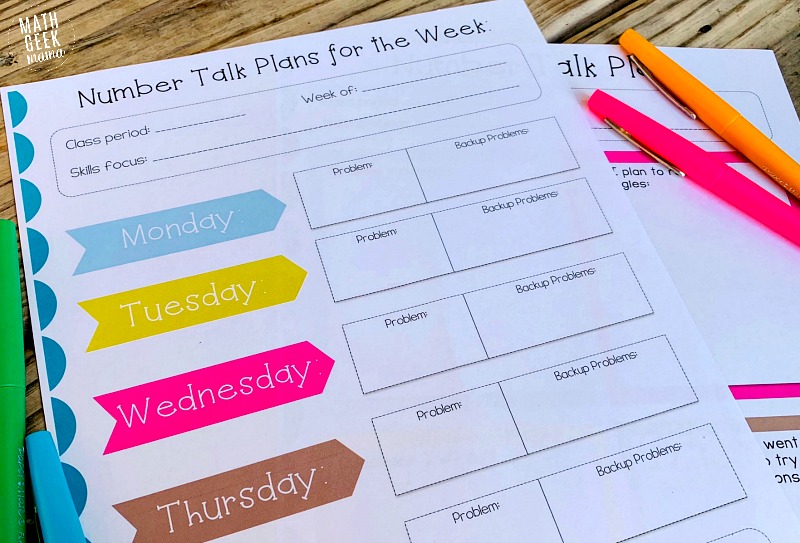
>>Read more: 5 Reasons Number Talks Should be a Regular Part of Your Math Routine
>>Get Started: Grab FREE Number Talk Planning Pages HERE
2. Mental Math Challenges
This set of mental math challenges is like a single number talk on steroids. These pages give a starting number and then a series of computation challenges for kids to solve mentally until they reach the end.

These are beneficial because you get to choose the starting number, meaning you can easily differentiate for different ability levels.
In addition, these can provide some quiet, independent practice, which is sometimes a good break from group number talks.
>>Get Started: Learn more and grab this FREE set of challenges HERE
3. Esti-Mysteries
Challenging kids with an esti-mystery is a unique kind of number talk. These were created by Steve Wyborney, and he has lots of additional sets available on his site here.

This allows you to weave in a variety of different skills practice and vocabulary review, along with estimation practice, an often neglected skill. Plus, kids LOVE these! It’s such a fun challenge.
>>Read More: Benefits of Esti-Mystery Challenges | FREE Esti-Mystery Recording Pages
>>Get Started: Grab a FREE set of Esti-mystery Challenges HERE
4. What’s the Question? Prompts
Again, this type of math prompt is sure to get your kids thinking, since it’s not what they’re used to. Way too often, kids see math as nothing but computation problems to solve. One problem that has one solution with one correct method to arrive at that solution.
So open ended challenges that force kids to think flexibly and consider math as more than a closed, single solution are a win in my book!
A ‘what’s the question?’ prompt flips a typical math problem on its head. Instead of giving kids a math problem or word problem and asking for the solution, you give them a ‘solution’ and ask, “What’s the question?” In other words, what might someone be looking for to arrive at this solution? What is a context that might provide this solution?
Sample Solutions:
- The solution is 42 square inches. What’s the question?
- The solution is 1 hour and 30 minutes. What’s the question?
- The solution is 67.7 meters. What’s the question?
Another way to use this type of prompt is to provide the beginning of a story problem and omit the given question.
For example, say your textbook includes this problem as practice:
Sarah and Ben each had $100. Sarah spent $57 on clothes and Ben spent $44 on a video game. How much more did Sarah spend than Ben?
Instead of presenting the entire problem to students, just give them the information to form a context. Leave out the “How much more did Sarah spend than Ben?” and instead ask, “What’s the question?”
You could even provide a numberless word problem and leave off the question. This adds an additional layer of things you can discuss as a group as students make sense of the situation and also think about what the question could be. For example,
Sarah and Ben each had some money. Sarah spent some on clothes and Ben spent some on a video game. What’s the question?
This opens it up more, because we don’t know who spent more, we don’t know how much they had at first, we don’t know if there’s money leftover, etc. This will force kids to think about different scenarios and the math implications.
5. Number or Fraction of the Day Challenges
These simple daily prompts will help kids to think about numbers multiple ways, a key to developing a strong number sense.
How exactly you implement this will depend on your grade level.
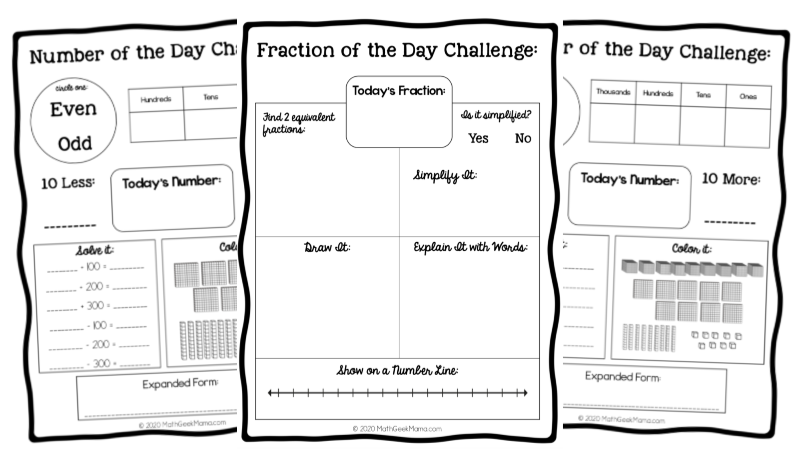
In the early grades, it might include writing the number in expanded form, showing with base ten blocks, +/- 1 and +/1 10, etc. Older students might focus on larger numbers and some place value addition and subtraction (daily number +500, -200, etc.).
Upper elementary students can build fraction sense by using fraction of the day prompts. This can include things like ‘find 2 equivalent fractions’ or ‘fraction + ___ = 1’. You can also have students place the faction on a number line or write a story problem equal to the given fraction.
This will help students think flexibly about whole numbers, fractions or even decimals.
>>Get Started: Grab a FREE set of number of the day prompts HERE
6. Target Number Challenge
Again, this is a super simple challenge that takes virtually no prep from you. There are so many benefits for students though. This math warm up will challenge kids to think about numbers in multiple ways, see patterns and learn to decompose numbers.
In this routine, you simply provide students a ‘target’ number. This can be anything at all, depending on the age and ability of your students.
Then set a timer for 5 minutes (or 10 minutes if your students are older and working with more complex numbers) and have kids record equations that are equal to the target number.
For example, if the target number is 10, students might write:
- 8 + 2 = 10
- 7 + 3 = 10
- 2 + 4 + 4 = 10
- 20 – 10 = 10
- 30 – 20 = 10
For older students, you can use larger numbers, or fraction and decimal values.
You can also add restraints or requirements such as, each equation must include 2 operations. Or each equation must include 4 different terms (20 – 12 + 6 – 4 = 10). Or each equation must use an exponent, etc.
7. Logic Puzzles as Math Warm-Ups
Lastly, I want to mention simple logic puzzles as a way to get your kids ‘warmed up’ and ready to learn math. Although logic puzzles won’t necessarily build fluency and computation skills, they are a fun way to ‘warm up’ the brain. They will also strengthen logical and critical thinking skills, which in turn better prepare and equip kids to make sense of word problems and other math challenges.
In addition, they can be a great way for kids to develop perseverance in problem solving, as the desire to solve the puzzle pushes them on in a way that a typical math problem may not.
>Read More: How to Raise Logical Thinkers and Why it Matters
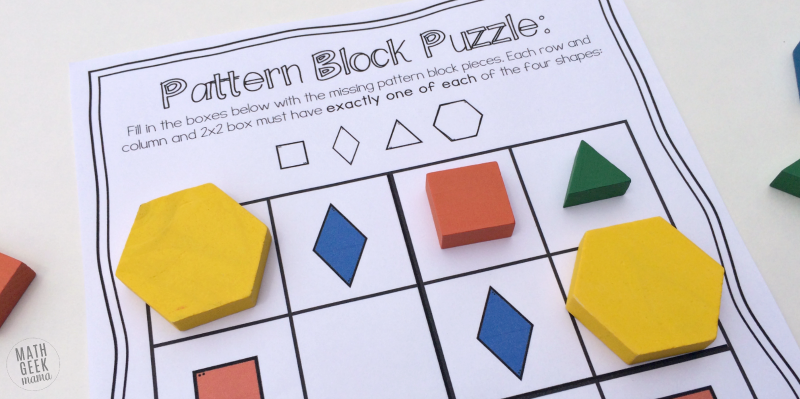
>>Get Started: Try any of the FREE sets of logic puzzles I have available at the links below, or purchase a complete set of puzzles, depending on the ages you’re looking for:
- Hands On Logic Puzzles with Pattern Blocks | ages 4-9
- A Year of Logic Puzzles (sudoku and grid puzzles with monthly themes) | ages 9+
FREE logic puzzles to try out:
- Set of 3 Pattern Block Puzzles
- Valentine’s Day Logic Puzzles
- Pi Day Logic Puzzles
- 4th of July Logic Puzzles
- Thanksgiving Logic Puzzles
- Christmas Logic Puzzles
Well, I hope this has given you some meaningful, easy to implement ideas for daily math warm ups and I hope you are encouraged to look for ways to strengthen number sense and build problem solving skills with the routines you use in your classroom!
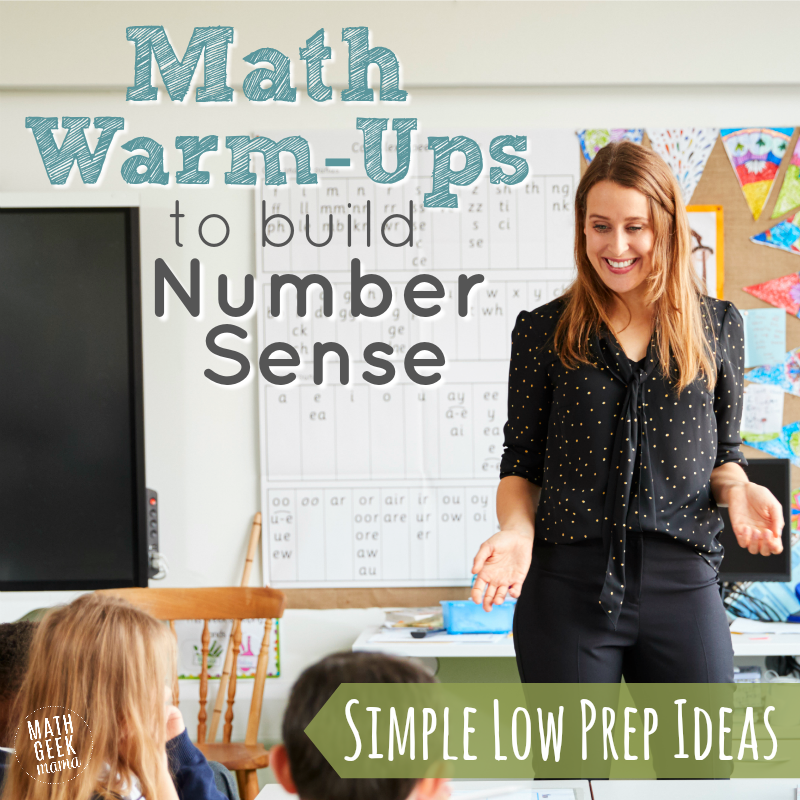
Have another easy math warm-ups routine to add to this list? Feel free to share it with me via email here: mathgeekmama(at)gmail.com.


